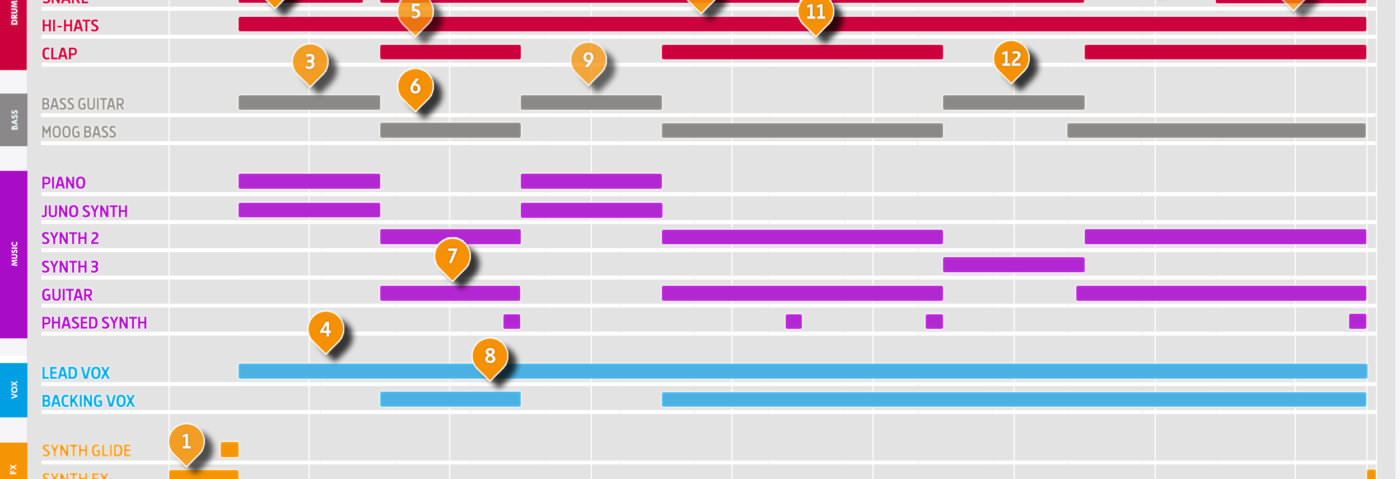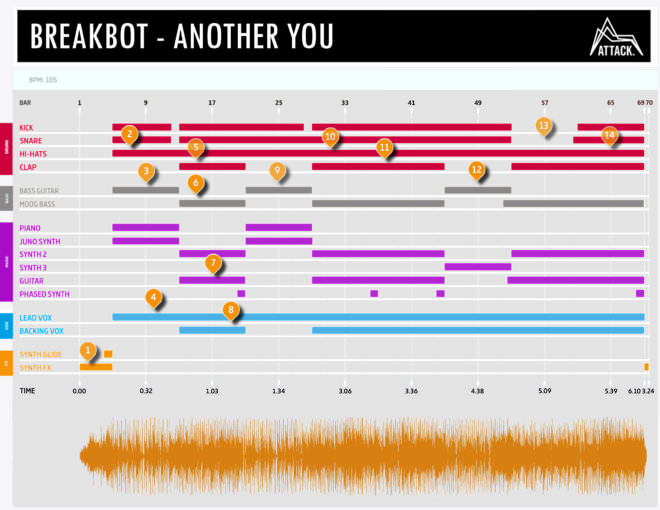In this instalment of Deconstructed, we turn the spotlight on Breakbot, aka French producer and DJ Thibaut Berland.
Breakbot’s triumphant return to the fore this year came with a fresh EP entitled ‘Another You’ released on Ed Banger Records. The EP’s title track is an upbeat pimptastic slice of old-school funk, dripping in squelchy synth bass and 80’s synths and with vocals supplied by regular collaborator and fellow producer/DJ Ruckazoid.
The version of ‘Another You’ that we’ve broken down below is the same that appears at the YouTube link, and at 2’45” is shorter than the EP version. The soundtrack for this includes several effects – whooshes, bangs and motorbike noises, for instance – that are purely part of the video soundtrack. We’ve not included most of these in our analysis, as they don’t form part of the original track and are only there to accompany the visual effects in the video.
The Track
THE ARRANGEMENT
WHAT’S HAPPENING?
- The first thing we hear is burst of static and a menacing synth growl, swelled by a mains buzz tone of the type generated by an unplugged live guitar lead (presumably intentional, since this is tuned to the root note of G). A polyphonic analogue synth glide joins the fray, sounding very like a classic Roland Juno 106 in Portamento mode, drifting up to a high Fsus2 chord and giving the impression of a spaceship preparing for takeoff. A sampled stick-click and distant spoken ‘one-two’ countoff precedes a long, lazy synth bass slide, followed by a small, two-chord synth riff and a short snare fill made up of two sixteenth notes that serves to bring in the verse.
- The verse groove that enters at bar 5 is a relatively simple one, but very effective. A warm, round, punchy kick on beats one and three, a dry, fat snare on two and four, and dynamic eighth-note hi-hats lay down a solid funk groove that moves things along at a strutting 105bpm. At the end of every second bar we get another short, two-stroke, sixteenth-note snare fill to keep things flowing through the whole of the eight-bar long first verse. The kick and snare drop out in the last bar to herald the chorus.
- There are two bass sounds in the track, and we hear the first of them here – a warm, natural electric bass guitar sound with a fat bottom end. The part is played with short, clipped notes, perfect for funk, the only exception being the pushed longer notes that play in sync with the keyboard stabs. The Cm7, Dm7, EbMaj7 chords are played both by a sustained acoustic piano sound and a stabby analogue polysynth, again reminiscent of a Juno 106, programmed with a brassy-sounding patch. The resonant filter is being shaped by the attack portion of the filter envelope, which opens out the cutoff frequency rapidly after each keystrike, emulating the rapid swell of a brass instrument in the characteristic way that only an analogue synth (or a virtual emulation of one) can.
- The lead vocal (courtesy of Ruckazoid) is super-compressed, which has the effect of enabling us to hear every detail in the voice. The dynamic range has been squashed so that setting the level high enough in the mix enables us to also hear every breath and lipsmack that wouldn’t normally be audible. Mixed relatively dry and upfront, with little in the way of obvious pitch adjustment, the result is a breathy, natural-sounding vocal. At the end of the verse section, there’s a double-repeat on the last two words “my hand”. This could either have been with an audio edit, or with a quarter-note delay and an automated send set to bring in the effect at that particular point.
- The chorus kicks in at bar 13, and it’s all change! The first new item is the addition of a clap loop to the drum track, doubling the snare, while the hi-hat pattern changes to a more sparse sequence of one- bar rests and swung sixteenth-note fills.
- Down in the depths, we get a new bass sound – an analogue synth very much in the style of the classic funk Minimoog bass. Once again, it’s all about a wound up filter resonance dial and that filter envelope, shaping the sound with a moderate attack time and a short decay to give that characteristic ‘wowp’ effect which is retriggered with every note.
- Keyboards-wise in the chorus, we’ve lost the piano, and the chords have changed sound to a similar brassy polysynth, but this time there’s a lot more phasing and chorus in evidence, particularly on the final chords. The new Gm7 and F major chords themselves are held longer than in the verse, and there’s a wobble in the sound that’s due to some slow LFO modulation – another classic Juno trait. Over in the left speaker, we have a low, plucked guitar or clav sound playing a short three-note riff every other bar, and the section rounds off with a pair of full, deeply-phased synth string and phased funk guitar chords.
- Time to talk backing vocals. While the lead continues as before, it’s accompanied by some highly-processed backing vocals delivering increasingly stacked harmonised answers to the main lyric, slotting nicely into the gaps left by the lead vocal. This kind of call-and-answer to-ing and fro-ing is a well-established songwriting technique for good reason – it works! In contrast to the lead, these have had some tuning applied, and the harmonies have a synthetic sound that indicates the use of a processor like Melodyne or VocalSynth. Effects-wise, there’s also plenty of phasing and chorus apparent.
- It’s bar 21, and we’re already into verse 2. We’ve reverted back to the same basic plan as verse 1, with a switch back to electric bass, no claps, straight hi-hats, piano and short brassy synth stabs. The eight-bar section progresses more or less as before, except this time round, when it gets to the end of the verse, it’s only the kick that drops out – the snare keeps going.
- Coming in at bar 29, chorus 2 is, by and large, a repeat of chorus 1. There’s nothing really new here to speak of, except that, for the benefit of the video, the last half-bar and beginning of the next section are filtered right down with a low pass filter over the entire mix to emulate being dunked underwater!
- The section that enters at Bar 37 could be labelled a tag, as sonically it’s identical to the eight-bar chorus that precedes it – all instruments and backing vocal parts are exactly the same, but the lead vocal sings a different melody, with some high tuned adlibs thrown in over the last couple of bars. A yowling flourish on the Moog bass rounds off this section with aplomb.
- Bar 45 takes us to the bridge, with new synth chords playing a new riff (Gm > F > F > Gm, Gm > C > C > Eb) beneath call and answer vocal riffs we haven’t previously heard. These have been sung on alternate tracks, so each has a slightly different character and you can hear them overlap as the lyrics run together. For most of the section, these are doubled lead vocals, but overlapping harmonies swoop back in in the last couple of bars.The bass in this part of the track is handled by the electric bass sound, but the section ends with the Moog synth bass re-entering with a flashy G minor pentatonic run down the keyboard, followed by an exuberant slide into the next part of the tune.
- The harmony backing vocals continue on into the breakdown at Bar 53. Here, the kick and snare drop out and we’re left with the chorus claps and hi-hat part fulfilling the percussion duties. The Moog bass continues on from the flashy run at the end of the bridge and continues playing the chorus bass part, up until the last bar where there’s another run up the keyboard this time, into the outro section. Aside from the missing drums, the instrumentation here resembles that found in the other chorus sections.
- At bar 61, the drums kick back in and resume the full chorus part for the final, eight-bar outro section of the song, which again closely resembles the other choruses in all but the lead vocal, which continues to riff and adlib around the existing melody and backing vocals. After a final ‘oo-oo-oo-oo’ backing vocal flourish, the track comes to a rather abrupt end at bar 69 with a final short burst of static.

